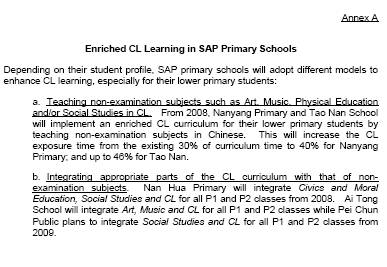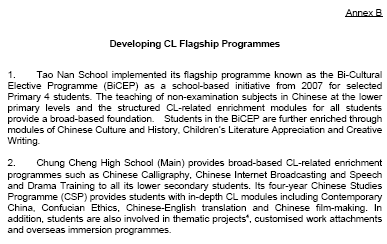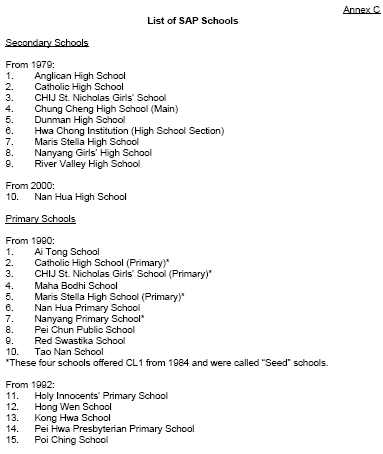|
Continued from
FrontPage of Article
(C) Provide More Opportunities for Overseas and
Local Immersion
To enhance their students’ understanding and
appreciation of Chinese culture and contemporary China, SAP schools
will provide their students with more opportunities for immersion in
China, including extended programmes of up to six months in key
Chinese cities. Hwa Chong Institution, for example, has started a
satellite campus in Beijing since September 2007, and will be
offering places for other SAP school students.
Nanyang Primary School, Nanyang Girls’ High School,
Nan Hua Primary School and Nan Hua High School will be piloting
local CL residential immersion programmes for some of their
students, lasting between two to four weeks, to immerse them in a
Chinese-speaking environment.
(D) Develop Flagship Programmes
MOE will support and encourage SAP schools to each
develop a CL-related flagship programme that adds to each school’s
educational identity, and exposes students to enriched learning in
Chinese language and culture.
Some of the SAP schools that have already started
doing so include Tao Nan School with its Bi-Cultural Elective
Programme and Chung Cheng High (Main) with its Chinese Special
Programme. (See details in Annex B)
(E) Enhance Values Education through Civics and
Moral Education and Inter-Ethnic Interaction
To deepen values education in SAP schools,
traditional Chinese values will be incorporated into the teaching of
the Civics and Moral Education curriculum where appropriate. This
will be piloted in 8 primary 2 and 7 secondary[3] schools in 2009.
If successful, this approach could be adopted by more SAP schools
subsequently.
SAP schools will also give their students more
opportunities to interact with other ethnic groups to help them
develop a better understanding of other races, and a strong sense of
responsibility to the nation. For example, SAP schools could partner
non-SAP schools to develop Co-Curricular Activities and community
service programmes that facilitate sustained interaction and
friendship between their students.
STRENGTHENING SAP SCHOOL ETHOS
(F) Identify and Nurture SAP School Leaders
As school leaders are key to shaping and maintaining
the school ethos, MOE will continue to ensure that SAP schools are
led by suitable leaders. As part of their professional development
and training, current and potential SAP school leaders will be
exposed to a range of structured development opportunities,
including Masters or executive programmes in Chinese and longer
overseas attachments to Chinese schools abroad.
(G) Create a Strong Community of SAP Schools
SAP schools will establish stronger networks among
themselves to nurture the SAP school ethos and create opportunities
for professional development and resource sharing. SAP schools will
work together on issues of common interest and provide effective
platforms for their students and teachers to share their
experiences.
STRENGTHENING SAP SCHOOL TEAMS
MOE will recruit suitable teachers to teach
non-examination subjects such as Music, Arts and Physical Education
in Chinese. Immersion and other development programmes for serving
CL teachers in SAP schools will also be organised.
MOE SUPPORT
MOE will provide SAP schools with the necessary
support to implement these initiatives. This includes providing
curricular consultancy support to SAP schools.
BACKGROUND
The SAP scheme was introduced in 1979 to preserve
the best traditions and ethos of the old Chinese medium schools, and
to nurture a core group of students who are proficient in both
English and Chinese. Currently, there are
SAP secondary schools and 15 SAP primary schools
(see list in Annex C).
Ministry of Education
11 February 2008




2 The primary schools are CHIJ St. Nicholas Girls’
School, Hong Wen School, Holy Innocents’ Primary, Nan Hua Primary,
Nanyang Primary, Pei Chun Public, Pei Hwa Presbyterian Primary and
Poi Ching School.
3 The secondary schools are Anglican High, CHIJ St.
Nicholas Girls’ School, Chung Cheng High (Main), Dunman High, Hwa
Chong Institution, Nan Hua High and River Valley High.
Source: www.moe.gov.sg
Press Release 11 Feb 2008

|